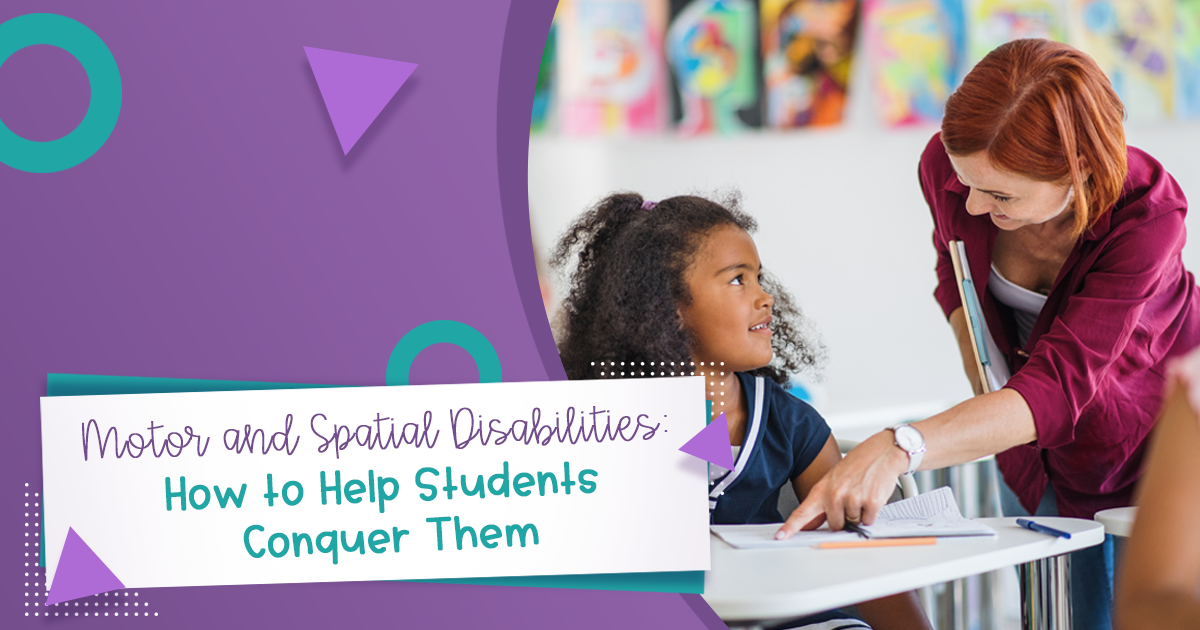
What is a motor perceptual disability? Students with difficulty in this area have a hard time coordinating their eyes to their hand movements. They often have a hard time holding, moving, or using a crayon or pencil. They might may seem very uncoordinated.
Below, you’ll find examples of things you might see students with motor perceptual disabilities doing in your classroom as well as some strategies for helping them overcome these difficulties.
1. Writes Uphill or Downhill
In math, this could cause students to solve math problems incorrectly. Their paper might seem unorganized or hard for you (and sometimes even them) to read. This is not what their brain WANTS to happen, but it is difficult for their brain and their hands to communicate and execute a plan.
Strategy: Utilize graph paper or a ruler to help them align their numbers as they work.
2. Difficulty Keeping Up or Copying
Time, effort, and energy spent on writing is unable to be used on actually solving math problems. For students who are really struggling to copy, write, or keep up, we might need to adjust the written demands that we are putting in front of them.
In my mind, you have to decide, which is more important? Copying the problem or doing the computation?
Strategy: How can we have a good balance of writing *some* of the problems without requiring them to do it all? I like to write the first number in an addition or subtraction problem. Then, students can write the second number below. Finding the right balance of writing is key!
3. Long Problems Are Hard
While long problems can be difficult for an array of reasons, for students who are struggling with organizing information in writing it can be especially difficulty. Students with motor disabilities often struggle to complete long problems.
Strategy: Break the problems into small manageable pieces. Help guide them through the problem one small piece at a time.
What is a spatial disability? Students with spatial disabilities struggle or organize and process information that is presented visually. They often cannot manipulate, find patterns, or change patterns in their mind.
1. Great at Rote Tasks
Students with spatial disabilities are often great at rote tasks, such as basic math computation. Things that you do each and every day are a strength for them. They might be the first person to share an answer in a small group, but when those same skills are taken to the next level, they often struggle. Word problems and practical applications are a challenge.
Strategy: Allow students get up and physically DO the actions that are described in a word problem. Allow them to test out their thoughts. This should be incorporated into their daily routine to help them become something that is rote.
2. First, Next, and Last
Words that describe the order are often challenging for students to understand. Even as a teacher, explaining these words can be challenging.
Strategy: Use visuals in the classroom to help them see these important words demonstrated.
3. Right, Left, Up, Down
Describing position can also be a challenge for students with spatial disabilities. How many adults struggle with left and right? 🙋🏻♀️ These words mean nothing to a student who is struggling to navigate the space around them.
Strategy: Use rote activities and games to help them practice these words. I also think that visuals, just like with first, next, and last, are a great tool for students to see every day.
4. Forming Numbers Incorrectly
Many of our students form numbers incorrectly. This is part of their difficulty with visual and spatial processing. Be on the lookout for students who struggle in this area and help them become more aware that particular numbers might be more difficult for them than others.
Strategy: Have visuals, such as a hundreds chart, available to students for self-checking.
5. Aligning Numbers
Math has SO many numbers and symbols. Accuracy in math relies heavily on getting all of the right numbers in all of the right places. If you notice that students have a hard time placing decimals or numbers in fractions in the correct places, this could be the result of low scores in spatial skills.
Strategy: Graph paper, lined paper turned sideways, and frames can help your students place numbers in the correct places.
